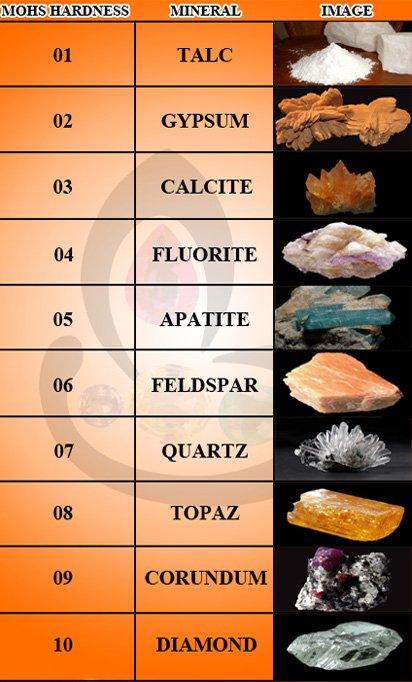What is a Mohs scale and how it is used?
German mineralogist Friedrich Mohs, image courtesy of IGS
The Mohs scale of mineral hardness is a scale used to measure the scratch resistance of various minerals or materials. It was developed by the German mineralogist Friedrich Mohs in 1812 and is named after him. The scale assigns a numerical value to the relative hardness of a mineral based on its ability to scratch another mineral. The higher the Mohs number, the harder the mineral, and the more resistant it is to scratching.
The scale is widely used in several fields, primarily in geology, mineralogy, and the jewellery industry. Here's why the Mohs scale is important and how it is used.
The Utilization of the Mohs Scale"
1. Mineral Identification:
1,138 ct single-crystal natural diamond, image courtesy of GIA
Geologists and mineralogists use the Mohs scale to identify unknown minerals in the field. By testing the hardness of a mineral sample against minerals of known hardness, scientists can narrow down the possibilities of its identity.
2. Jewellery Industry:
In the jewellery industry, the Mohs scale helps determine the suitability of gemstones for specific uses. Harder gemstones are used in rings, which are subject to frequent wear and tear, while softer gemstones might be used in earrings or pendants where they are less likely to be scratched.
3. Material Selection:
Lapidary, image courtesy of Goldsmiths centre
Engineers and material scientists use the Mohs scale to select appropriate materials for various applications. For example, in industrial settings, materials used for cutting or grinding tools need to be harder than the materials they process.
4. Understanding Durability:
The Mohs scale provides a simple and practical way to understand the relative durability of different minerals and materials. It helps people make informed decisions about how to handle, use, and care for various substances.
5. Educational Tool:
The Mohs scale serves as an essential educational tool, especially in schools and universities, where it helps students grasp the concept of mineral hardness in a tangible way. It provides a hands-on approach to understanding the physical properties of minerals and how they compare to one another.
6. Historical Significance:
The Mohs scale has a rich historical significance in the field of mineralogy. It represents one of the earliest attempts to quantify and standardize the hardness of minerals, contributing significantly to the systematic study of Earth's natural resources.
7. Conservation and Preservation:
Museums and conservationists use the Mohs scale to assess the susceptibility of artefacts and historical objects to wear and tear. Understanding the hardness of materials helps preserve these items for future generations by choosing appropriate display and storage methods.
8. Innovations in Technology:
The scale continues to be relevant in modern technology. In fields like metallurgy and engineering, where the hardness of materials is crucial, the Mohs scale informs the development of new alloys and composites that can withstand specific conditions, ensuring the longevity and efficiency of various technological applications.
Mohs Scale List
Mohs scale chat, image courtesy of Gemstone Universe
Talc: The softest mineral on the Mohs Scale, often used in powdered form.
Gypsum: Slightly harder than talc, gypsum is commonly used in construction materials.
Calcite: Found in limestone and marble, calcite is relatively soft and can be scratched by harder minerals.
Fluorite: Known for its vibrant colors, fluorite is used in various industrial applications.
Apatite: Apatite crystals are used in jewellery, but they require careful handling due to their moderate hardness.
Orthoclase Feldspar: A component of granite, orthoclase feldspar has moderate hardness and is used in ceramics.
Quartz: Quartz crystals are widely used in electronics and jewellery, representing a hardness level of 7.
Topaz: Topaz gemstones are prized for their beauty and durability, ranking 8 on the Mohs Scale.
Corundum: Corundum includes sapphires and rubies, making it one of the hardest gemstones on Earth (hardness level 9).
Diamond: The hardest mineral on the Mohs Scale, diamonds are coveted for their brilliance and durability.
Identify Gemstone Hardness
To assess a gemstone's hardness, compare it with the minerals on the Mohs Scale. For instance, if a gemstone can scratch quartz (hardness level 7) but not topaz (hardness level 8), its hardness falls between 7 and 8 on the Mohs Scale. This identification process helps gemstone enthusiasts gauge the durability of various gems.
FAQs
Q: Can the Gemstone Mohs Scale Determine Gemstone Value?
Absolutely, a gemstone's hardness affects its value. Gemstones with higher Mohs hardness are rarer and more valuable due to their durability and resistance to scratches.
Q: Is Gemstone Hardness the Only Factor to Consider in Jewelry Making?
While hardness is crucial, other factors like color, clarity, and cut also influence gemstone selection. Balancing these characteristics ensures aesthetically pleasing and durable jewelry pieces.
Q: Can Gemstones Scratch Each Other?
Yes, gemstones with lower Mohs hardness can be scratched by those with higher hardness. Careful consideration of gemstone combinations is essential to avoid damage.
Q: Are Diamonds the Hardest Gemstones on the Mohs Scale?
Yes, diamonds top the Mohs Scale at level 10. Their exceptional hardness makes them ideal for various jewelry applications, symbolizing enduring love and strength.
Q: How Can I Care for Gemstones Based on Their Mohs Hardness?
Understanding a gemstone's hardness guides proper care. Softer gems require gentle cleaning and careful storage, while harder stones can withstand more rigorous maintenance.






